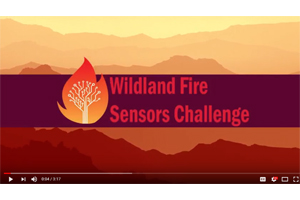Winners of the Wildland Fire Sensors Challenge Develop Air Monitoring System Prototypes
In 2017, EPA and five other federal agencies issued a Wildland Fire Sensors Challenge to improve smoke monitoring and provide data to protect public health. Sensor developers and researchers were encouraged to develop new and innovative air sensor monitoring technologies to measure air pollutants from smoke during wildland fires. Smoke from fires is harmful to health that can irritate the eyes, nose and throat, cause persistent coughing, wheezing and difficulty breathing and worsen heart and lung disease.
EPA and partners presented the awards to the winners at the Air Sensors International Conference on Sept. 12, 2018, in Oakland, California.
On this page:

Jason Gu (left) and Bryan Tomko of SenSevere/Sensit Technologies in Pittsburgh, Pennsylvania, with R. Subramanian of Carnegie Mellon University, received first place and $35,000.
Sensit Air Quality Monitoring Stations
Second Place Award

Scott Waller (left) and Andrew Smallridge of Thingy LLC, Bellevue, Wash. received second place and $25,000.
Thingy AQ Wildfire Real-time Smoke & Air Quality Monitoring System
Honorable Mention

Javier Fernandez (left) and Miguel Escribano of Kunak Technologies®, Pamplona, Spain received an honorable mention.
EPA and partners conducted the Challenge to address the need for air monitoring capabilities during a wildfire. While regulatory-grade systems provide reliable measurements, they are stationary, not always close to wildland fires, and complex to operate. Easily deployable and accurate air sensor systems are needed by firefighters, air quality advisors, community health officials and others to assess air quality conditions and provide forecasts during a wildland fire.
Designers of sensor systems for measuring wildfire smoke face significant technological challenges. Affordable, transportable, easy- to- use and reliable instruments are needed that can be deployed near a fire where firefighters are working and in communities impacted by smoke. Current systems in use have limitations and do not meet all these requirements. At the same time, wildfires produce harsh environmental conditions for monitoring equipment. High concentrations of pollutants and high temperatures near a fire can cause equipment to malfunction.
The Challenge sought sensors that measure four air pollutants emitted or generated from wildland fires: Fine particulate matter (PM2.5), carbon monoxide (CO), ozone (O3), and carbon dioxide (CO2) The air measurement experts also called for the design of systems that would be portable, durable, reliable, wireless and comparable to regulatory monitors.
The winners of the Challenge used emerging technologies including miniaturized direct-reading sensors, compact microprocessors, and wireless data communications to develop prototypes for measuring smoke from wildland fires.
The Wildland Fire Sensors Challenge has increased awareness of the monitoring needs during wildfires and served as a catalyst for advancing the next generation of sensor technology systems for wildland fire applications to protect public health. EPA’s federal partners are the U.S. Forest Service, NASA, National Oceanic and Atmospheric Administration (NOAA), Centers for Disease Control and Prevention (CDC), and National Park Service (NPS).
The air sensor prototypes submitted underwent rigorous two-phase laboratory testing by EPA and the US Forest Service (USFS), a federal partner, for accuracy over a wide range of operation requirements relevant for wildland fire deployment.
The first phase involved testing in a controlled air chamber in EPA's research laboratory in Chapel Hill, North Carolina, where the systems were compared with regulatory-grade instruments also in the chamber. The second phase of testing was conducted at the USFS research facility in Missoula, Montana. There, the experts tested the systems during simulation of wildland fire smoke conditions, alongside regulatory monitors. The systems were also assessed for their ease of use and their ability to transmit data over long distance.

